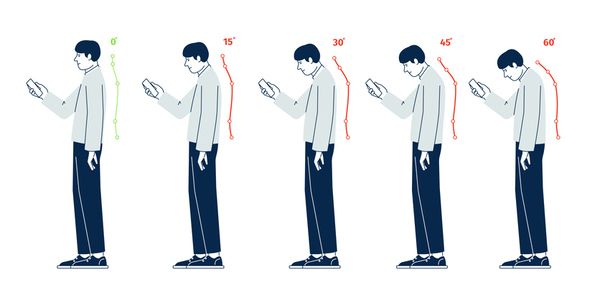Is There Really Such a Thing as Text Neck?
What is Text Neck?

Yes, there really is a condition termed Text Neck. It refers to a condition stemming from the strain on the neck caused by frequently looking down at a mobile device or other electronic device over extended periods. This posture can lead to a variety of symptoms, including neck pain, stiffness, soreness, and headaches.
When the head tilts forward, the force on the neck surges significantly, leading to increased pressure and strain on the neck muscles, tendons, and ligaments. This can also affect the spine’s curvature and potentially lead to long-term musculoskeletal problems.
To help prevent the effects of text neck, it is recommended that you maintain good posture, take frequent breaks, and hold devices at eye level to minimize the need to bend the neck forward.
Implications for Teens
Text neck is of particular concern with teens. This is due, of course, to their high usage of smartphones and other handheld devices for texting, browsing, gaming, and social media. Teenagers often spend hours each day looking down at their devices, leading to an increased risk of experiencing the symptoms associated with text neck. These symptoms include not just neck pain but also shoulder pain, headaches, and changes in cervical spine curvature.
The implications for teens are particularly concerning because their bodies are still developing, which means that prolonged poor posture can lead to long-term musculoskeletal issues, including alterations in the natural curve of the spine, premature degeneration of vertebrae, and reduced respiratory function. Additionally, posture can affect overall well-being, potentially leading to decreased physical activity and a negative impact on mental health due to pain and discomfort.
What You Can Do to Combat Text Neck
To combat the effects of text neck in teens, it’s important to encourage good posture, regular breaks from screen time, and exercises that strengthen the neck, shoulders, and back. Educating teenagers on the importance of holding devices at eye level and reducing the amount of time spent on devices can also help mitigate these issues.
Getting Help
Whether you should see a specialist for text neck depends on the severity and persistence of your symptoms. If you experience occasional discomfort, making adjustments to your posture, taking regular breaks from device use, and performing neck and shoulder exercises may suffice to alleviate your symptoms.
However, if you experience persistent or severe pain, discomfort, headaches, or any other concerning symptoms, it’s advisable to consult a healthcare professional. Here are some signs that you should see a specialist:
- Persistent Pain: If the pain in your neck, shoulders, or back doesn’t improve with home remedies like rest, improved posture, and exercises, it’s time to see a doctor.
- Increasing Symptoms: If symptoms worsen over time, instead of getting better, professional assessment is necessary.
- Numbness or Tingling: If you experience numbness, tingling, or weakness in your arms or hands, this could indicate nerve involvement and requires immediate medical attention.
- Impact on Daily Activities: If the discomfort affects your ability to carry out daily activities or impacts your quality of life, seeking medical advice is recommended.
- Lack of Improvement: If you’ve made all the recommended adjustments and don’t see any improvement within a few weeks, a specialist can help identify underlying issues or recommend physical therapy, chiropractic care, or other treatments.
